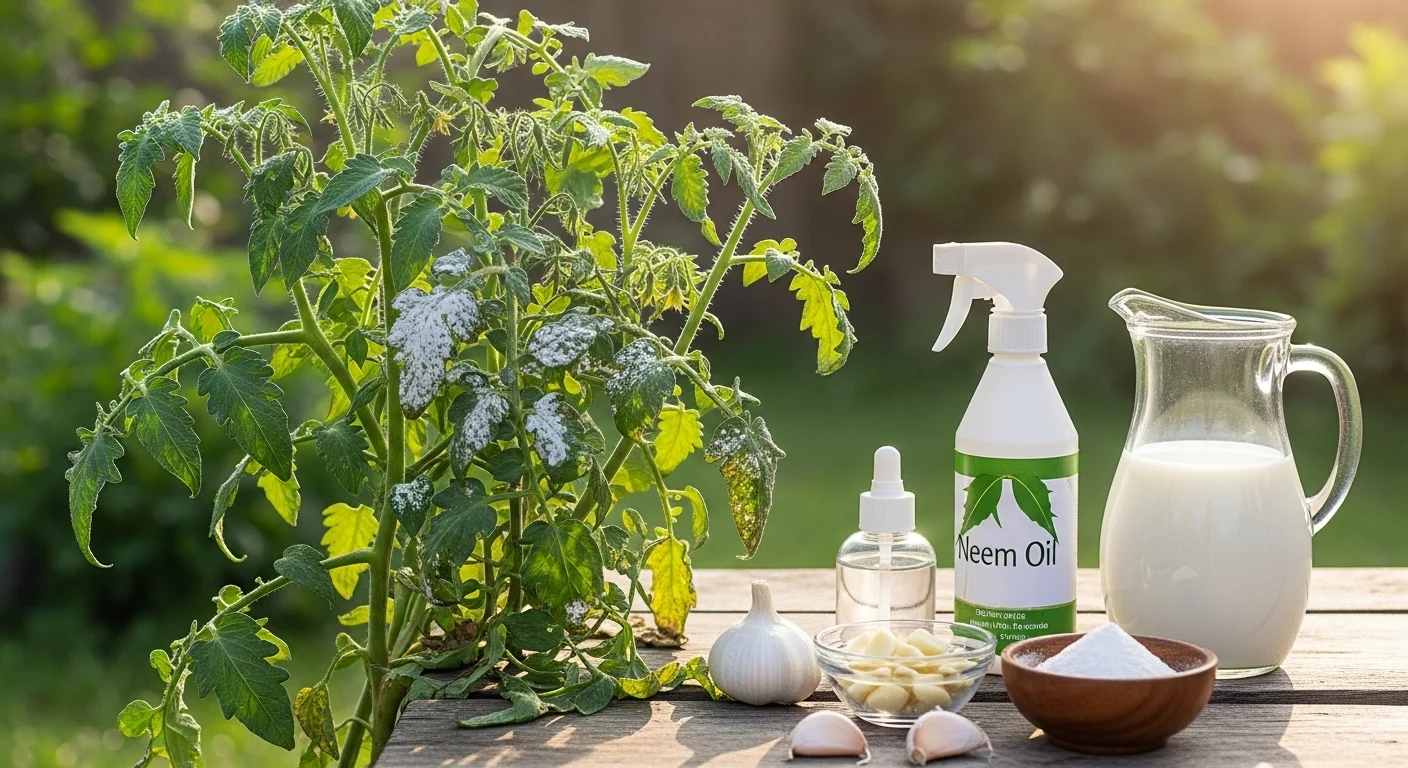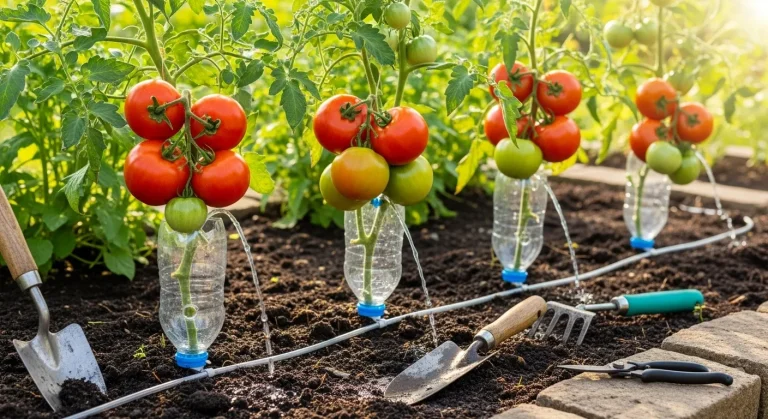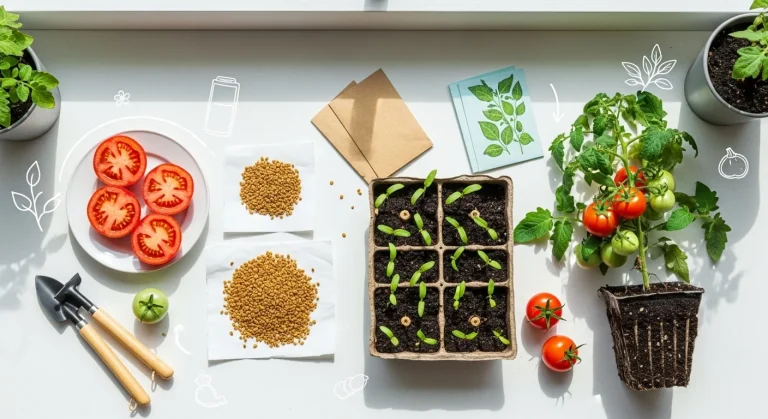Fungal infections are the quickest way to turn a promising tomato crop into a patch of yellowing leaves and shriveled fruit.
They creep in during humid spells, splash up from wet soil, and spread faster than most gardeners can react. The good news is, you don’t always need expensive chemicals—simple home remedies can help when used correctly, alongside smart cultural practices.
This guide blends science-backed methods with field-tested tips so beginners can follow along and experienced growers still learn something new.
It’s written for home gardeners and small-scale farmers who want clear recipes, realistic expectations, and long-term control.
Quick Look: Types of Common Tomato Fungus
- Late blight: Water‑soaked, greasy-looking brown patches that expand fast; white fuzz under leaves in cool, wet weather; can destroy plants and fruit quickly.
- Early blight: Brown spots with target‑like rings on older leaves first; spreads upward after rains and humidity; reduces vigor and yield.
- Powdery mildew: White powder on leaf surfaces; common in warm days/cool nights with poor airflow; weakens plants over time.
- Septoria leaf spot: Many small, round spots with dark margins and pale centers starting low on the plant; thrives with rain splash and dense canopies.
Tip: If the entire plant suddenly wilts with brown streaks in stems, consider bacterial wilt—not a fungus. Nutrient problems usually don’t create distinct, spreading spots with halos or powdery growth.
Home Remedies That Actually Work
Each remedy includes: what it is, how to prepare/use, why it works, and limitations. Use these as part of an integrated approach—no single spray is a silver bullet.
1) Baking Soda Spray (DIY tomato fungus spray)
- What it is: A simple foliar spray using sodium bicarbonate (baking soda) that changes leaf surface pH to make it less friendly to fungi.
- How to prepare/use:
- Mix 1 tsp baking soda + 0.5 tsp mild liquid soap (as spreader‑sticker) in 1L water. Optional: add 0.5 tsp light vegetable oil if no potassium soap is available.
- Spray in the early morning, coating both sides of leaves until just shy of runoff.
- Repeat every 5–7 days; reapply after heavy rain.
Why it works: Bicarbonate can inhibit spore germination and hyphal growth by disrupting cell processes at higher pH on the leaf surface.
- Limitations:
- Works best as a suppressive, not a cure for severe infections.
- Over‑strong mixes or midday spraying can scorch leaves.
- For aggressive late blight in cool‑wet conditions, effect is limited.
For side‑by‑side symptom checks and management steps, see this university guide to late blight in tomatoes and potatoes.
- Pro tip: If available, potassium bicarbonate is usually more effective and gentler—use 0.5–0.75 tsp/L with a mild soap.
2) Neem Oil (Cold‑Pressed) + Potassium Soap
- What it is: A botanical oil from neem seeds with antifungal and anti‑feeding effects; the soap helps emulsify and improves spread.
- How to prepare/use:
- In 1L water, dissolve 2–3 ml potassium soap. Slowly whisk in 5 ml cold‑pressed neem oil.
- Spray fine mist in the morning, covering upper and lower leaf surfaces.
- Repeat weekly; alternate with other remedies if disease pressure persists.
- Why it works: Neem’s active compounds (e.g., azadirachtin) can reduce pathogen pressure and support plant health; also suppresses pests like whiteflies and thrips that worsen disease by stressing plants and vectoring viruses.
- Limitations:
- Not a stand‑alone solution for fast‑moving late blight.
- Do not use in strong sun or above ~32°C; can burn leaves.
- Never mix with sulfur products; avoid spraying during bee activity.
3) Milk or Whey Spray (Science‑backed)
- What it is: Diluted dairy spray that can suppress powdery mildews and some leaf spot development.
- How to prepare/use:
- Mix fresh milk 1:9 with water (10% milk). Alternatively, whey at 10–20%.
- Spray mornings every 5–7 days; ensure good coverage.
- Why it works: Milk proteins and beneficial microflora can inhibit some fungi and trigger mild plant defenses.
- Limitations:
- Residue may appear as a white film—harmless; wipe test to confirm it’s not mildew.
- In very hot, direct sun, residues may increase leaf heat; avoid midday applications.
- Works best for powdery mildew and mild leaf spot pressure; limited against late blight.
4) Garlic Spray
- What it is: A DIY extract using garlic’s sulfur‑containing compounds with antimicrobial properties.
- How to prepare/use:
- Crush 8–10 garlic cloves; steep in 1L warm water for 12–24 hours.
- Strain; add 0.5 tsp mild soap for spread; use immediately.
- Spray early mornings every 5–7 days, especially after humid nights.
- Why it works: Allicin and related compounds exhibit antifungal activity and can deter some pests; as a foliar, it can slow early infections and reduce surface inoculum.
- Limitations:
- Potency varies with preparation; results can be inconsistent.
- Strong odor; may irritate skin/eyes—use gloves and avoid windy spraying.
- Not sufficient for severe late blight; use as part of a rotation with bicarbonate or milk.
5) Compost Tea (Aerated or Simple Steep) for Prevention
- What it is: A water extract of mature compost applied to leaves and soil to promote beneficial microbes that compete with pathogens.
- How to prepare/use:
- Simple method: Steep 1 part well‑finished compost in 5–10 parts clean water for 12–24 hours; strain through cloth; use the same day.
- Spray leaves lightly in the morning; also drench soil around roots.
- Repeat every 10–14 days during humid periods.
- Why it works: Competitive exclusion—beneficial microbes can occupy leaf surfaces and root zones, lowering pathogen success; may also improve plant vigor.
- Limitations:
- Hygiene matters. Use mature compost and clean tools; don’t store. Discard if it smells foul.
- Preventive benefit is stronger than curative effect; pair with targeted sprays when disease is visible.
6) Cultural Practices That Punch Above Their Weight
- What it is: Low-cost changes in plant care that reduce fungal pressure dramatically.
- How to prepare/use:
- Air circulation: Stake and tie vines; remove crowded lateral growth; prune lower leaves up to the first fruit truss.
- Pruning: Remove badly infected leaves—bag and bin them (don’t compost if disease is heavy).
- Spacing: Avoid leaves touching between plants; aim for good light penetration.
- Watering: Irrigate at the base in early morning; avoid wetting leaves at night.
- Mulching: Apply 3–5 cm straw/coco mulch to stop soil splash of spores.
- Why it works: Fungi love wet, crowded, stagnant air. Dry leaves, airflow, and clean soil contact break the disease cycle.
- Limitations:
- Requires consistent habits; early neglect is hard to undo.
- Excessive pruning in heat can stress plants—balance is key.
Remedies That Don’t Really Work (But People Still Try)
- Vinegar sprays: Strong acids burn leaves and don’t reliably stop fungi at safe concentrations; risky and counterproductive.
- Cola/soft drinks: Sugar can feed microbes; acidity isn’t a precise antifungal tool; sticky leaves invite pests and sooty molds.
- Random kitchen hacks (turmeric paste on leaves, undiluted essential oils, heavy Epsom salt): Either block stomata, burn foliage, or lack consistent efficacy without proper emulsifiers and dosing.
- Overuse of hydrogen peroxide: Brief disinfectant action but damages leaf tissue and beneficial microbes; not a sustainable foliar strategy.
Explaining why these fail builds trust: effective fungal control needs correct concentration, good coverage, compatible timing, and realistic expectations.
Preventive Measures for Long‑Term Success
- Crop rotation: Keep tomatoes and other solanaceous crops off the same bed for 2–3 years.
- Mulching: Straw or coco mulch to stop rain splash from soil‑borne spores.
- Watering at the base: Drip or careful can watering; morning only.
- Removing infected leaves: Prune early and often; sanitize pruners with 70% alcohol.
- Resistant or tolerant varieties: Choose locally proven varieties for monsoon and heat; ask nearby growers or nurseries.
- Soil and vigor: Balanced nutrition (avoid excess nitrogen); adequate calcium and magnesium for sturdy growth; stressed plants succumb faster.
Pro Tips That Separate Good From Great
- Combine wisely: Add a mild soap to baking soda or garlic sprays for even coverage and better leaf adhesion.
- Morning window: Spray at sunrise or early morning—leaves dry slowly and safely; avoid hot midday sun.
- Be consistent: One spray won’t reverse established disease; think in 2–3 applications over 10–14 days.
- Alternate modes: Rotate between bicarbonate, milk/whey, neem, and garlic to avoid leaf stress and keep pressure on fungi.
- Weather watch: Skip sprays before rain or on windy days; reapply after heavy rainfall.
Putting It All Together: A Simple 14‑Day Plan
Prune infected lower leaves, sanitize tools, mulch the soil surface, stake and space plants for airflow.
- Day 1: Choose a primary remedy based on what you see:
- Powdery mildew → Milk/whey (10–20%) or potassium bicarbonate.
- Early blight/Septoria → Baking soda (1 tsp/L) + mild soap; or potassium bicarbonate.
- Seedlings/nursery → Focus on hygiene and consider compost tea drench; for prevention, add a biological like Trichoderma as a soil drench (follow label).
- Day 4–5: Inspect new growth; spot‑prune; reapply selected spray if weather stays humid.
- Day 7: Alternate method (e.g., switch from milk to bicarbonate; add neem+soap if pests are present).
- Day 10–12: Repeat application; maintain base watering and dry foliage.
- Day 14: Evaluate. If disease is receding, extend interval to weekly; if progressing (especially in cool‑wet spells), increase pruning, improve airflow further, and consider a one‑time copper product per label as a last resort if allowed locally.
Also Read : Tomato Crop Duration in India: Key Growth Stages
Troubleshooting: Quick Answers
- Leaves burned after spraying?
- Likely too strong a mix, midday application, or incompatible mixing (e.g., oils with sulfur). Rinse foliage next morning, skip a cycle, resume at proper dilution.
- No improvement after 2 weeks?
- Recheck diagnosis (is it bacterial or abiotic?), rotate remedy, step up pruning and hygiene, and reduce canopy density. Persistent cool‑wet weather may require a stronger labeled product.
- It rained after I sprayed!
- If within 6–12 hours, reapply next clear morning.
- White film after milk spray—mildew or residue?
- Wipe a small area; if it rubs off easily, it’s residue. If it spreads and won’t wipe, keep treating for powdery mildew.
Safe Use and Compatibility
- Do not mix: neem + sulfur; copper + milk/dairy; bicarbonate + acidic solutions (they neutralize).
- Personal safety: Wear gloves and eye protection; always test on a few leaves and wait 24 hours before full‑plant spraying.
- Edible safety: Rinse fruits. Leave at least 24 hours after spraying before harvest, especially after neem or soaps.
Conclusion
Fungal problems are common, but they’re manageable with accurate identification, precise dosing, and consistent care.
Start with practical home remedies—baking soda, milk/whey, neem, garlic—and lock in prevention through airflow, mulching, and smart watering.
Test, track, and tweak what works best in your conditions. Healthy tomato plants mean healthier harvests—and it all starts with the right care at home.




Leave a Comment